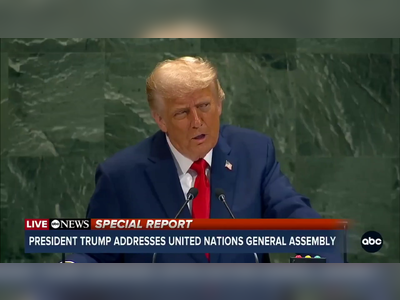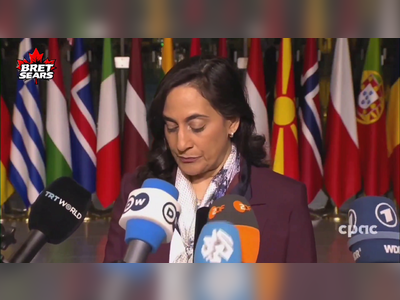Devastating Wildfires: A New Chapter in California’s Fiery History
President Biden labels ongoing blazes around Los Angeles as the most severe in the state's history, as casualties rise and mass evacuations continue.
As fires continue to rage across Los Angeles, burning through vast tracts of land and risking lives, President Joe Biden has described these wildfires as the 'most devastating' in California’s history.
Since Tuesday, multiple fires have spread in Southern California, with difficulties stemming from extreme drought and formidable Santa Ana winds fuelling their growth.
In the recent updates, the death toll from these catastrophic events remains uncertain.
US media outlets have reported conflicting figures, ranging from six to seven casualties.
The 'Palisades Fire,' currently the largest of these blazes, claimed an additional life, bringing the devastation directly to Pacific Palisades and surrounding areas.
Malibu and other close regions are also grappling with these deadly fires, with confirmations of fatalities.
Despite reconnaissance and firefighting efforts mobilizing over 7,500 personnel, containment has proved challenging.
The 'Palisades Fire' has expanded to approximately 8,000 hectares, displaying unpredictable behavior in the steep and rough terrain in its path.
Similarly, the 'Eaton Fire' near Pasadena has grown to more than 5,500 hectares and remains fully uncontained, though wind conditions that had accelerated its spread have abated somewhat.
New threats arise as the 'Kenneth Fire' has emerged in the West Hills, advancing rapidly towards residential zones.
Meanwhile, a measured relief comes from the 'Sunset Fire' in Hollywood Hills, where authorities have lifted evacuation orders as containment gains ground, yet sporadic flare-ups around the city persist.
The enormity of the fires has forced the evacuation of over 300,000 residents, among them numerous celebrities and public figures, from areas including Pacific Palisades and Altadena.
The gravity of the situation prompted Vice President Kamala Harris to cancel an upcoming international engagement, underscoring the national focus required in these trying times.
The material cost is staggering, with at least 10,000 buildings reduced to rubble.
Fire Chief Kristin Crowley notes that in Pacific Palisades alone, over 5,300 structures have been entirely consumed by flames.
The relentless destruction has left whole districts in ashes, heightening the urgency of firefighting efforts and disaster management.
Beyond the direct environmental impact, the fires have stirred criminal activity in evacuee zones, where reports of looting have surfaced, adding to the chaos.
Authorities, led by Los Angeles County's Kathryn Barger, have issued a stern warning, resulting in 20 arrests, as law enforcement strives to maintain order and protection for vacated properties.
These infernos are symptomatic of a broader pattern of climate-driven disasters intensifying globally.
As California faces one of its most fiery onslaughts with concerns about continued flare-ups and new outbreaks, the fires pose significant challenges to both local infrastructures and national policies managing natural disasters.
The situation remains dynamic, demanding vigilance and substantial on-ground efforts to safeguard communities and landscapes alike.
Since Tuesday, multiple fires have spread in Southern California, with difficulties stemming from extreme drought and formidable Santa Ana winds fuelling their growth.
In the recent updates, the death toll from these catastrophic events remains uncertain.
US media outlets have reported conflicting figures, ranging from six to seven casualties.
The 'Palisades Fire,' currently the largest of these blazes, claimed an additional life, bringing the devastation directly to Pacific Palisades and surrounding areas.
Malibu and other close regions are also grappling with these deadly fires, with confirmations of fatalities.
Despite reconnaissance and firefighting efforts mobilizing over 7,500 personnel, containment has proved challenging.
The 'Palisades Fire' has expanded to approximately 8,000 hectares, displaying unpredictable behavior in the steep and rough terrain in its path.
Similarly, the 'Eaton Fire' near Pasadena has grown to more than 5,500 hectares and remains fully uncontained, though wind conditions that had accelerated its spread have abated somewhat.
New threats arise as the 'Kenneth Fire' has emerged in the West Hills, advancing rapidly towards residential zones.
Meanwhile, a measured relief comes from the 'Sunset Fire' in Hollywood Hills, where authorities have lifted evacuation orders as containment gains ground, yet sporadic flare-ups around the city persist.
The enormity of the fires has forced the evacuation of over 300,000 residents, among them numerous celebrities and public figures, from areas including Pacific Palisades and Altadena.
The gravity of the situation prompted Vice President Kamala Harris to cancel an upcoming international engagement, underscoring the national focus required in these trying times.
The material cost is staggering, with at least 10,000 buildings reduced to rubble.
Fire Chief Kristin Crowley notes that in Pacific Palisades alone, over 5,300 structures have been entirely consumed by flames.
The relentless destruction has left whole districts in ashes, heightening the urgency of firefighting efforts and disaster management.
Beyond the direct environmental impact, the fires have stirred criminal activity in evacuee zones, where reports of looting have surfaced, adding to the chaos.
Authorities, led by Los Angeles County's Kathryn Barger, have issued a stern warning, resulting in 20 arrests, as law enforcement strives to maintain order and protection for vacated properties.
These infernos are symptomatic of a broader pattern of climate-driven disasters intensifying globally.
As California faces one of its most fiery onslaughts with concerns about continued flare-ups and new outbreaks, the fires pose significant challenges to both local infrastructures and national policies managing natural disasters.
The situation remains dynamic, demanding vigilance and substantial on-ground efforts to safeguard communities and landscapes alike.
Translation:
Translated by AI
AI Disclaimer: An advanced artificial intelligence (AI) system generated the content of this page on its own. This innovative technology conducts extensive research from a variety of reliable sources, performs rigorous fact-checking and verification, cleans up and balances biased or manipulated content, and presents a minimal factual summary that is just enough yet essential for you to function as an informed and educated citizen. Please keep in mind, however, that this system is an evolving technology, and as a result, the article may contain accidental inaccuracies or errors. We urge you to help us improve our site by reporting any inaccuracies you find using the "Contact Us" link at the bottom of this page. Your helpful feedback helps us improve our system and deliver more precise content. When you find an article of interest here, please look for the full and extensive coverage of this topic in traditional news sources, as they are written by professional journalists that we try to support, not replace. We appreciate your understanding and assistance.










